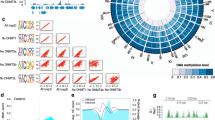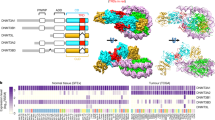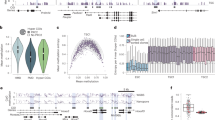Abstract
The methylation of vertebrate DNA at the 5-position of ∼3–10% of its cytosine residues occurs in a sequence-specific and tissue-specific manner1–3 and has been implicated in the control of transcription1,4–7. How these differences are established and how they mediate the initiation or maintenance of transcription are unknown. DNA methylation might also have other roles, such as modulating DNA replication, transposition, DNA repair or chromosome configuration1,8,9. These other roles suggested for DNA methylation would be consistent with the finding that tissue-specific differences in methylation of certain gene regions5, highly repeated satellite DNA sequences8–10 and whole genomes2,3 often do not correlate with transcriptional activity. For DNA methylation to modulate the expression, maintenance or duplication of chromosomes, there should be effector macromolecules, presumably proteins, which specifically recognize 5-methylcytosine (m5C) residues in DNA. We describe here the first identification of a mammalian protein that binds preferentially to m5C-rich DNA sequences.
This is a preview of subscription content, access via your institution
Access options
Subscribe to this journal
Receive 51 print issues and online access
$199.00 per year
only $3.90 per issue
Buy this article
- Purchase on Springer Link
- Instant access to full article PDF
Prices may be subject to local taxes which are calculated during checkout
Similar content being viewed by others
References
Ehrlich, M. & Wang, R. Y.-H. Science 212, 1350–1357 (1981).
Gama-Sosa, M. A. et al. Biochim. biophys. Acta 740, 212–219 (1983).
Ehrlich, M. et al. Nucleic Acids Res. 10, 2709–2721 (1982).
Felsenfeld, G. & McGhee, J. Nature 296, 602–603 (1983).
Cooper, D. N. Human Genet. 64, 315–333 (1983).
Doerfler, W. A. Rev. Biochem. 52, 93–124 (1983).
Busslinger, M., Hurst, J. & Flavell, R. A. Cell 34, 197–206 (1983).
Sano, H. & Sager, R. Proc. natn. Acad. Sci. U.S.A. 79, 3584–3588 (1982).
Gama-Sosa, M. A., Wang, R. Y.-H., Kuo, K. C., Gehrke, C. W. & Ehrlich, M. Nucleic Acids Res. 11, 3087–3095 (1983).
Sturm, K. S. & Taylor, J. H. Nucleic Acids Res. 9, 4536–4546 (1981).
Rigby, P. W. J., Dieckmann, M., Rhodes, C. & Berg, P. J. molec. Biol. 113, 237–251 (1977).
Riggs, A. O., Suzuki, H. & Bourgeois, S. J. molec. Biol. 48, 67–83 (1970).
Lacks, S. & Greenberg, B. J. biol. Chem. 242, 3108–3120 (1962).
Messing, J. & Viera, J. Gene 19, 269–276 (1982).
Ley, T. J., Anagnou, N. P., Pepe, G. & Nienhuis, A. W. Proc. natn. Acad. Sci. U.S.A. 79, 4775–4779 (1982).
Baas, P. D. et al. J. molec. Biol. 152, 615–639 (1981).
Kuo, T.-T., Huang, T.-C. & Teng, M.-H. J. molec. Biol. 34, 373–375 (1968).
Kuo, K. C., McCune, R. A., Gehrke, C. W., Midgett, R. & Ehrlich, M. Nucleic Acids Res. 8, 4763–4776 (1980).
Huang, L.-H., Farnet, C.M., Ehrlich, K.C. & Ehrlich, M. Nucleic Acids Res. 10, 1579–1591 (1982).
Klysik, J., Stirdivant, S. M., Singleton, C. K., Zacharias, W. & Wells, R. D. J. molec. Biol. 168, 51–71 (1983).
Behe, M. & Felsenfeld, G. Proc. natn. Acad. Sci. U.S.A. 77, 4597–4601 (1981).
Warren, R. A. J. A. Rev. Microbiol. 34, 137–158 (1980).
Vogt, V. M. Eur. J. Biochem. 33, 192–200 (1973).
Ehrlich, M., Ehrlich, K. & Mayo, J. A. Biochem. biophys. Acta 395, 109–119 (1975).
Author information
Authors and Affiliations
Rights and permissions
About this article
Cite this article
Huang, LH., Wang, R., Gama-Sosa, M. et al. A protein from human placental nuclei binds preferentially to 5-methylcytosine-rich DNA. Nature 308, 293–295 (1984). https://doi.org/10.1038/308293a0
Received:
Accepted:
Issue Date:
DOI: https://doi.org/10.1038/308293a0
This article is cited by
-
Predictive value of m5C regulatory gene expression in pancreatic adenocarcinoma
Scientific Reports (2021)
-
Regulation of equine infectious anemia virus expression
Journal of Biomedical Science (1998)
-
Biological aspects of cytosine methylation in eukaryotic cells
Experientia (1991)
-
DNA cytosine methylation and heat-induced deamination
Bioscience Reports (1986)
Comments
By submitting a comment you agree to abide by our Terms and Community Guidelines. If you find something abusive or that does not comply with our terms or guidelines please flag it as inappropriate.



